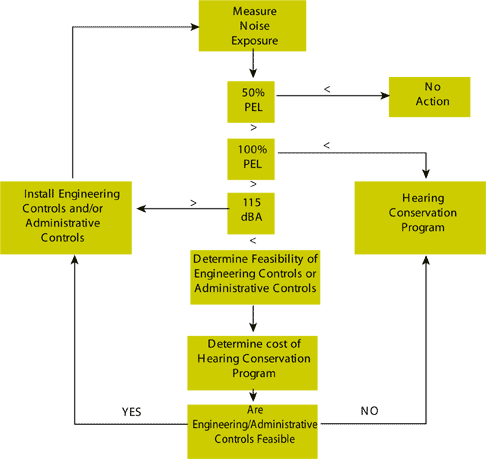
Industrial Applications
Employees exposed to excessive in-plant
industrial noise may be at risk to suffer a
variety of physiological and psychological
consequences. Other intangible effects have
also been hypothesized to be caused by
stress associated with noise exposure.
Prevention of hearing loss is the focus of
hearing conservation programs. It is the only
physiological effect that has an undisputed,
well documented association to noise exposure
in humans. The table below summarizes
some of the possible effects that are
linked to noise exposure. Total employee
exposure includes recreational sources.
Effects Linked To Noise Exposure
|
Physiological | Psychological | Other |
- Hearing Loss
- Hypertension
- Muscle Reactions
- Cardiac Disease
- Ulcers
- Colitis
- Heart Palpitations
- Headaches
- Nausea
|
- Stress
- Insomnia
- Annoyance/Irritation
- Lack of Concentration
- Low Morale
- Learning Disability
- Mental Fatigue
- Fear
- Anxiety
|
- Absenteeism
- Speech Interference
- Compromising Safety
- Sleep Interference
- Worker Productivity
- Job Satisfaction
- Mood Disturbances
|
Noise Induced
Hearing Loss
 The basic mechanism of hearing involves converting
sound waves hitting the ear drum to structure-borne
vibrations transmitting through bones in the middle ear.
From there, vibrations are changed into nerve impulses
in the cochlea of the inner ear. The fluid filled cochlea
contains 40,000 tiny hair cells like the one shown at
right (magnified) that initiate the nerve impulse which
is transmitted to the brain. With repeated exposure to
excessive noise, these hair cells lose some of their
resilience and may even break off resulting in
sensorineural or noise induced hearing loss. Hearing
loss is permanent because once damaged, the hair cells
can never be repaired or replaced. The basic mechanism of hearing involves converting
sound waves hitting the ear drum to structure-borne
vibrations transmitting through bones in the middle ear.
From there, vibrations are changed into nerve impulses
in the cochlea of the inner ear. The fluid filled cochlea
contains 40,000 tiny hair cells like the one shown at
right (magnified) that initiate the nerve impulse which
is transmitted to the brain. With repeated exposure to
excessive noise, these hair cells lose some of their
resilience and may even break off resulting in
sensorineural or noise induced hearing loss. Hearing
loss is permanent because once damaged, the hair cells
can never be repaired or replaced.
The Federal Noise Standard For Employee
Exposure As Developed By OSHA
(Occupational Safety & Health Administration)
|
Permissible Noise Exposures (OSHA) |
Duration per Day
(Hours) | Sound Level dBA
(Slow Response) |
| 8 | 90 |
| 6 | 92 |
| 4 | 95 |
| 3 | 97 |
| 2 | 100 |
| 1-1/2 | 102 |
| 1 | 105 |
| 1/2 | 110 |
| 1/4 or less | 115 |
Note that OSHA Permits a 5dB Increase in Permissible Levels
for a Reduction of 2:1 in Exposure Time
(Often Referred to as the 5dB Exchange Rate). |
Key Points
- 8 hours at 90 dBA equals the permissible
exposure level (100% dose)
- 8 hours at 85 dBA equals 50% of the
permissible exposure level (PEL)
- The OSHA Standard was formulated to
minimize not eliminate the risk of
hearing loss
- Dosimeters, not sound level meters,
are used to establish employee exposure/
dose
- Feasible engineering controls MUST be
implemented when the equivalent dose
for 8 hours exceeds 90 dBA or where
continuous noise is over 115 dBA
OSHA Derating
Instructions For All
Hearing Protectors
Using NIOSH Method #2
| 1) Take NRR from package | 29 NRR |
| 2) Subtract (7) dB | - 7dB |
| 22 |
| 3) Divide by (2) or 50% | ÷ 2 |
| 4) OSHA adjusted NRR | 11 |
A comprehensive hearing conservation
program guideline was added to the original
OSHA standard. The hearing conservation
amendment outlines requirements for annual
audiometric testing, training and documentation/
record keeping.
OSHA Compliance Strategy Summary

Caution!
Hearing
Protective
Devices' (HPD)
Noise Reduction
Ratings (NRR)
May Over
Estimate
Performance
A recent study by Dennis A.
Giardino and George Durkt, Jr. of the Mine
Safety and Health Administration
published in the American Industrial
Hygiene Association Journal compared
field performance to the EPA noise reduction
rating (NRR). The results from some
1,265 hearing protective device (HPD)
evaluations showed that field performance is
significantly less than that specified by the
NRR, especially for low frequency noise.
Results also showed that the NRR is not a
good indicator for comparing relative performance
of HPD models.
Conducting An Industrial Noise
Control Survey
Listed below are several of many possible
questions that need to be researched as part
of the noise control survey to determine feasible
and practical treatments/solutions.
Meeting the acoustical requirements alone is
not sufficient to solve the problem in most
cases. Identifying all the needs of the noise
control treatment can best be accomplished
by soliciting input from all disciplines that
might be affected. Forming a noise control
team with representatives from maintenance,
operations, quality control, production, safety,
engineering, management, etc. will assure
the best possible design to meet the needs of
all involved. Preliminary input from the
parties involved leads to "ownership" and
"buy-in" creating a sense of accomplishment
for the team.
| 1) | What is the noise source? |
| 2) | Where is the noise source? Please describe the room or area around the source. Is
it inside or outside? |
| 3) | What noise readings do you have from the source and/or the problem area?
______ dBA
Enter octave band analysis readings below.
63_____ 125_____ 500_____ 1000_____ 2000_____ 4000_____ 8000_____ |
| 4) | Which of the following regulations apply to this project?
OSHA______ EPA______ Insurance Policy______ Corporate Standard______ |
| 5) | How much reduction is desired? |
| 6) | How many workers are exposed to the noise source and for how long? |
| 7) | If an operator is involved, can he or she be isolated from the machine? |
| 8) | Can the walls and/or ceiling be treated? |
| 9) | How many reflective surfaces are near the source? |
| 10) | Do the workers and/or operators wear any hearing protection? If so, what kind? |
| 11) | Can the machine, equipment or system be enclosed? |
| 12) | How frequent is access to the source necessary? |
| 13) | How critical is visibility of the source? ...to the operator? |
| 14) | What special conditions should be taken into consideration? (i.e. temperature, fire
codes, harsh environment, aesthetics, etc.) |
| 15) | Would this be a temporary or permanent installation? |
| 16) | Who would do the installation? |
|






 The basic mechanism of hearing involves converting
sound waves hitting the ear drum to structure-borne
vibrations transmitting through bones in the middle ear.
From there, vibrations are changed into nerve impulses
in the cochlea of the inner ear. The fluid filled cochlea
contains 40,000 tiny hair cells like the one shown at
right (magnified) that initiate the nerve impulse which
is transmitted to the brain. With repeated exposure to
excessive noise, these hair cells lose some of their
resilience and may even break off resulting in
sensorineural or noise induced hearing loss. Hearing
loss is permanent because once damaged, the hair cells
can never be repaired or replaced.
The basic mechanism of hearing involves converting
sound waves hitting the ear drum to structure-borne
vibrations transmitting through bones in the middle ear.
From there, vibrations are changed into nerve impulses
in the cochlea of the inner ear. The fluid filled cochlea
contains 40,000 tiny hair cells like the one shown at
right (magnified) that initiate the nerve impulse which
is transmitted to the brain. With repeated exposure to
excessive noise, these hair cells lose some of their
resilience and may even break off resulting in
sensorineural or noise induced hearing loss. Hearing
loss is permanent because once damaged, the hair cells
can never be repaired or replaced.